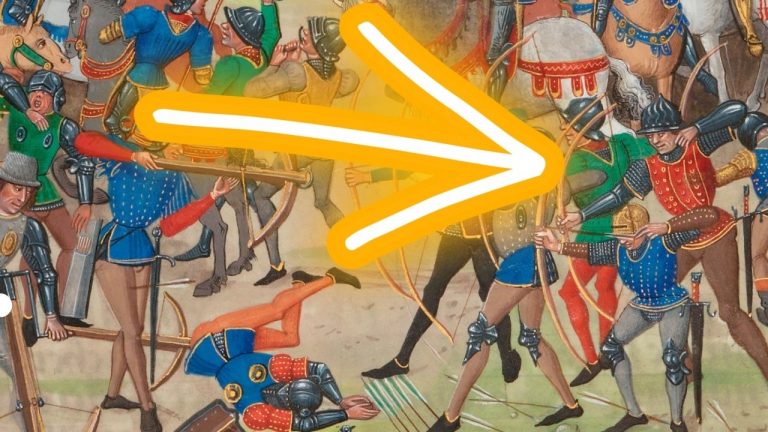[et_pb_section fb_built=”1″ _builder_version=”4.7.7″ _module_preset=”default”][et_pb_row _builder_version=”4.7.7″ _module_preset=”default”][et_pb_column type=”4_4″ _builder_version=”4.7.7″ _module_preset=”default”][et_pb_text _builder_version=”4.7.7″ _module_preset=”default”]Henry Tudor emerged victorious at the Battle of Bosworth. It was almost the final play in the battles known as the Wars of the Roses. It occurred on the morning of the 22nd of August 1485 near the town of Market Bosworth in Leicestershire.
Henry’s forces defeated those of
Richard III.
Richard’s forces were severely depleted on the morning of the battle with several defections, namely the Earl of Northumberland and the powerful Stanley family. Having previously declared for the Yorkist Richard, they now turned up and fought for the Lancastrian Henry.
The battle cumulated with a last gasp desperate charge by Richard III. He had a small band of loyal troops and charged straight at Henry Tudor. Richard was an experience war commander, whereas this was Henry’s first experience of battle. Henry’s bodyguards did their job well, keeping him away from the action. Richard was cut down in an attempt to kill his rival. He remains the final King of England to die in battle.
After the battle, Richard’s gold circlet from his armour was found lying discarded in a hawthorn bush. On what is now known as Crown Hill, close to the battlefield, Henry Tudor knelt and was
crowned king of England by Lord Stanley.
However… the question remains did Henry Tudor have a legitimate claim to the throne of England?
This article attempts to answer that very question.
In short, Henry Tudor’s claim to the throne of England comes through his mother,
Margaret Beaufort. Her direct line of descent goes back through John of Gaunt to Edward III. However, that line was explicitly barred from ever inheriting the throne of England. So technically, Henry Tudor did not have a legitimate claim to the throne.
But that is not the end of the story…[/et_pb_text][/et_pb_column][/et_pb_row][et_pb_row _builder_version=”4.7.7″ _module_preset=”default”][et_pb_column type=”4_4″ _builder_version=”4.7.7″ _module_preset=”default”][et_pb_text _builder_version=”4.7.7″ _module_preset=”default”]
The Wars of the Roses
[/et_pb_text][/et_pb_column][/et_pb_row][et_pb_row _builder_version=”4.7.7″ _module_preset=”default” column_structure=”1_5,3_5,1_5″][et_pb_column _builder_version=”4.7.7″ _module_preset=”default” type=”1_5″][/et_pb_column][et_pb_column _builder_version=”4.7.7″ _module_preset=”default” type=”3_5″][et_pb_image src=”http://historywithhenry.com/wp-content/uploads/2022/02/1-2.png” _builder_version=”4.7.7″ _module_preset=”default” alt=”Did Henry VII have a legitimate claim to the throne ” title_text=”1″ hover_enabled=”0″ sticky_enabled=”0″][/et_pb_image][/et_pb_column][et_pb_column _builder_version=”4.7.7″ _module_preset=”default” type=”1_5″][/et_pb_column][/et_pb_row][et_pb_row _builder_version=”4.7.7″ _module_preset=”default”][et_pb_column type=”4_4″ _builder_version=”4.7.7″ _module_preset=”default”][et_pb_text _builder_version=”4.7.7″ _module_preset=”default”]For almost 30 years, the Kingdom of England was decimated by a bloody and brutal Civil War that was initially known as the cousin’s war but has now become referred to as the Wars of the Roses.
On one side, there was the house of
York, which had for its emblem or white rose. On the other side was the house of Lancaster, which had for its emblem a red rose.
Both had lines of decent going back to Edward III. The Lancastrian side through Edward’s third son John of Gaunt and the Yorkist side through the female relations of both Edward’s second and fourth sons.
It was a somewhat completed situation.
The Lancastrians were in possession of the crown and had been for many years since Henry IV. There was little argument at this point.
However, the Lancastrian King Henry VI was classed as mad for extended periods. Richard, Duke of York, thought he would do a much better job of running the country. He probably had a point.
However, the Lancastrians and specifically Henry VI’s wife, Margaret of Anjou, disagreed. She had the added motivator of having the inheritance of her son, Edward of Westminster, to protect.
It all kicked off at St Albans on the 22nd May 1455.
For the next thirty years, the crown would pass multiple times between the rival houses and a large number of the leading claimants to the throne were killed.[/et_pb_text][/et_pb_column][/et_pb_row][et_pb_row _builder_version=”4.7.7″ _module_preset=”default”][et_pb_column type=”4_4″ _builder_version=”4.7.7″ _module_preset=”default”][et_pb_text _builder_version=”4.7.7″ _module_preset=”default”]
Who was Henry Tudor?
[/et_pb_text][/et_pb_column][/et_pb_row][et_pb_row _builder_version=”4.7.7″ _module_preset=”default” column_structure=”1_5,3_5,1_5″][et_pb_column _builder_version=”4.7.7″ _module_preset=”default” type=”1_5″][/et_pb_column][et_pb_column _builder_version=”4.7.7″ _module_preset=”default” type=”3_5″][et_pb_image src=”http://historywithhenry.com/wp-content/uploads/2022/02/2-2.jpg” _builder_version=”4.7.7″ _module_preset=”default” alt=”Did Henry VII have a legitimate claim to the throne ” title_text=”2″ hover_enabled=”0″ sticky_enabled=”0″][/et_pb_image][/et_pb_column][et_pb_column _builder_version=”4.7.7″ _module_preset=”default” type=”1_5″][/et_pb_column][/et_pb_row][et_pb_row _builder_version=”4.7.7″ _module_preset=”default”][et_pb_column type=”4_4″ _builder_version=”4.7.7″ _module_preset=”default”][et_pb_text _builder_version=”4.7.7″ _module_preset=”default”]Henry Tudor was born in Pembroke Castle on 28th January 1457. He was the only child of Edmund Tudor and Margaret Beaufort.
Edmund Tudor was the half brother of the king of England, Henry VI. His mother was Catherine Valois, the widow of the famed Henry V. Even though his mother was a former Queen of England, Edmund Tudor had no claim on the English throne. He was descended from the union between Catherine and Owen Tudor. It isn’t even clear if Henry V’s widow married Owen Tudor. What is known is they had two children, the oldest Edmund and the younger Jasper. Henry VI openly acknowledged both men as his half brothers. He relied on them as his power base in Wales.
Margaret Beaufort was the sole heiress of the powerful Beaufort inheritance. This made her a valuable asset in the marriage market. An earlier marriage when she was just three years of age, purely for political purposes, was annulled after a few years. At just 12 years of age, she married Edmund Tudor.
Margaret Beaufort was a descendent of John of Gaunt. Hence, she was on the Lancastrian side of the royal family.
In the ordinary course of events, this Beaufort line would have a potential claim on the throne of England. However, there was a very severe complication.
The Beaufort line resulted from John of Gaunt’s relationship with his mistress Katherine Swynford. This was a long-term relationship, and John of Gaunt truly loved her. When John of Gaunt’s wives died (he had two of them), he married Katherine Swynford.
After that marriage, the Beaufort line was no longer considered illegitimate. The king allowed it to be legitimised in law. This meant that titles, properties, and money could be easily passed down that line without legal complication or stigma.
The was, however, one strict caveat.
The Beaufort line could not claim the throne.
It’s unclear what the reasons for that caveat are. But, with it in place, Margaret Beaufort’s claim on the throne and subsequently her sons claim on the throne is null and void.
The Wars of the Roses got to the point that the last possible Lancastrian client was Henry Tudor. He knew his status and position and lived in exile on the continent.
Just as an aside, there were other Lancastrian claimants to the throne, but there were Spanish. (Indeed, there is an argument that Catherine of Aragon had a greater claim to the throne than
Henry VIII – but that is an article for another day.)
For those keen on removing Richard III from power, Henry Tudor represented the last hope.[/et_pb_text][/et_pb_column][/et_pb_row][et_pb_row _builder_version=”4.7.7″ _module_preset=”default”][et_pb_column type=”4_4″ _builder_version=”4.7.7″ _module_preset=”default”][et_pb_text _builder_version=”4.7.7″ _module_preset=”default”]
How did Henry VII keep his hands on the throne?
[/et_pb_text][/et_pb_column][/et_pb_row][et_pb_row _builder_version=”4.7.7″ _module_preset=”default” column_structure=”1_5,3_5,1_5″][et_pb_column _builder_version=”4.7.7″ _module_preset=”default” type=”1_5″][/et_pb_column][et_pb_column _builder_version=”4.7.7″ _module_preset=”default” type=”3_5″][et_pb_image src=”http://historywithhenry.com/wp-content/uploads/2022/02/3-1.jpg” _builder_version=”4.7.7″ _module_preset=”default” alt=”Did Henry VII have a legitimate claim to the throne ” title_text=”3″ hover_enabled=”0″ sticky_enabled=”0″][/et_pb_image][/et_pb_column][et_pb_column _builder_version=”4.7.7″ _module_preset=”default” type=”1_5″][/et_pb_column][/et_pb_row][et_pb_row _builder_version=”4.7.7″ _module_preset=”default”][et_pb_column type=”4_4″ _builder_version=”4.7.7″ _module_preset=”default”][et_pb_text _builder_version=”4.7.7″ _module_preset=”default”]Henry Tudor managed to put an army together. He arrived in Wales and marched towards battle with Richard.
As we know already, Henry Tudor emerged victorious at Bosworth.
Here is the clever bit.
Henry Tudor, or Henry VII as he was now known, didn’t shout too loudly about his decent line.
Instead, he claimed the throne through the right of conquest.
In other words, he had defeated the present king in battle and therefore was now the king.
No one could argue with him. Richard III was, after all, dead.
He then went about shoring up his claim. He started collecting other potential Yorkist claimants to the throne and imprisoning them in the Tower of London. Principally, the Earl of Warwick who was the son of the Duke of Clarence, Richard III’s older brother.
Then, he married the other potential claimant, Elizabeth of York. Elizabeth was the daughter of
Edward IV. Her two brothers were the Princes in the Tower, and we can assume that Henry VII was satisfied that they were dead.
There were several rebellions by people claiming to be one of the two missing Princes, but they were soon put down.
Henry VII never felt fully secure on the throne throughout his reign.
However, his son,
Henry VIII, was the union of the two houses and never really feared an alternative claimant.[/et_pb_text][/et_pb_column][/et_pb_row][/et_pb_section]






